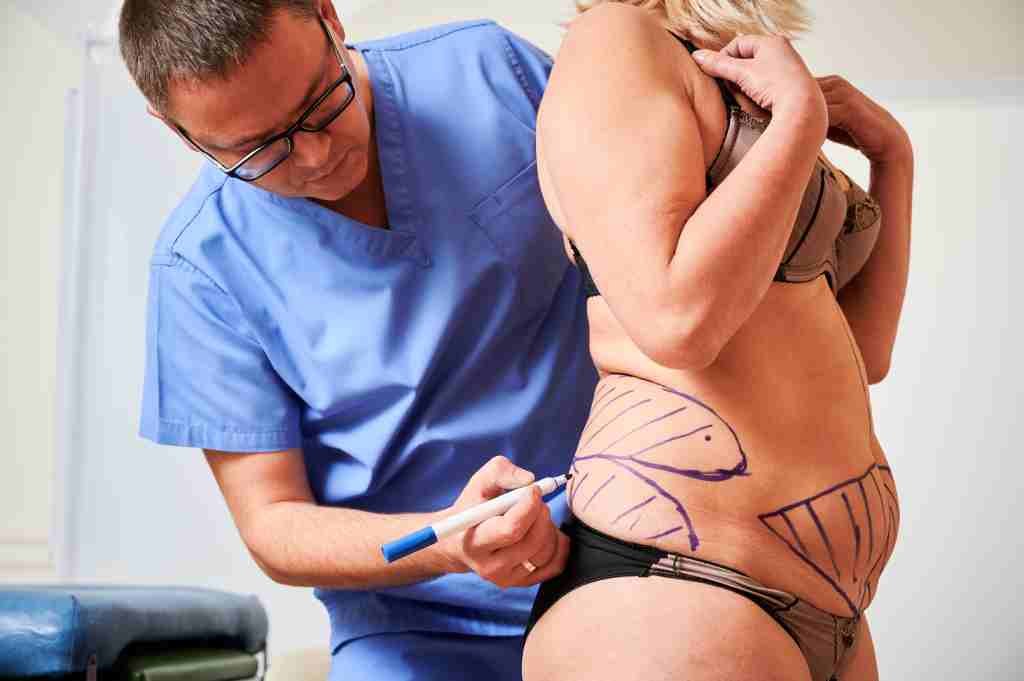Body Aesthetic
In today’s world, looking and feeling good means having a fit, well-proportioned body. However, for many people, this may seem like an unreachable goal. Sometimes even a strict diet or a disciplined exercise program can’t conquer stubborn areas of excess fat. For those who seek a smoother or better-proportioned body contour, liposuction may be the answer. Liposuction, also called lipoplasty, is a surgical procedure that removes deposits of excess fat from specific areas of the body, face or neck. Liposuction can be used to slim the hips and thighs, flatten the abdomen, shape the calves and ankles or eliminate a double chin. You’ll find basic information about liposuction in this brochure. However, the best way to get complete answers to specific questions that relate to your individual needs is to have a personal consultation with a plastic surgeon certified by the Board of Plastic Surgery.
Is liposuction right for me?
• Cheeks chin and neck
• Upper arms
• Breast or chest area
• Back
• Abdomen and waist
• Hips and buttocks
• Thighs
• Inner knee
• Calves and ankles
It’s important to be clear, about a few “can’s and cant’s” related to liposuction
• be used to treat some cases of gynecomastia, or male breast enlargement, which occurs in both teenagers and adult men.
Liposuction can’t. . .
• serve as a substitute for dieting and exercise
• Effectively treat cellulite (a condition that gives the skin a dimpled appearance).
a) Liposuction can slim the hips and thighs and provide a more shapely contour for the inner knee, calves and ankles.
b) Liposuction can flatten the abdomen, remove fat from the under-arms, eliminate a double chin and contour the face or neck
Also, certain medical conditions may complicate liposuction. They include: diabetes, high blood pressure or heart disease and previous surgery near the area to be contoured. It’s important to let your plastic surgeon know if you have any of these medical conditions or if you have had surgery in the past.
c)”Love handles” and a large abdomen, typical problems for men, respond well to liposuction. Liposuction can also be used to treat gynecomastia (male breast enlargement
d) After liposuction, you will see a noticeable difference. After swelling and fluid retention have subsided, your results will be even more apparent.
What should I expect from the consultation?
You should arrive at the consultation ready to provide complete information about:
• Previous surgical procedures
• Past and present medical conditions
• Medications you are taking, including herbal remedies or nutritional supplementsDepending on the parts of your body that you would like to be treated with liposuction, you may be asked to undress. Your surgeon will fully assess the extent of correction needed. You’ll also be asked to point out the exact areas where you would like to see improvement. Your surgeon will check the elasticity of your skin and may feel certain areas to assess the thickness of the underlying layer of fat. Your surgeon will also check your blood pressure and weight, and ask you if you are planning to lose or gain weight in the future.
How is liposuction performed?
To perform liposuction, one or more small incisions are made near the area to be suctioned. Whenever possible, incisions are placed within the natural folds or contour lines of the skin so that they are inconspicuous. The surgeon then places a slim, hollow tube called a cannula through the incision so that its tip penetrates the underlying fat. After the cannula is connected by flexible tubing to a suction pump, the surgeon moves the cannula back and forth through the fat, which is vacuumed into the tube. Several variations to the basic liposuction technique have been introduced.
The fat-removal technique that best meets your needs depends on a number of individual factors that your surgeon will discuss with you.
• Your surgeon may use the tumescent technique, in which the fat is pre-injected with a salt-water solution containing small amounts of adrenaline and sometimes local anesthetic.
• Your surgeon may also use ultrasound-assisted lipoplasty or UAL, a two-step technique that uses the energy from sound waves to liquefy the fat before it is suctioned.
• The type of instrumentation used may also vary. For some areas, a hand-held syringe may be used to provide the vacuum instead of a suction pump.
How will I learn about the safety of liposuction?
One of the most important parts of your consultation is the discussion that you and your surgeon will have about the possible complications of liposuction. In addition to listening carefully to what your surgeon tells you, be sure to raise any questions or concerns that you may have about the safety of the procedure. By carefully following your surgeon’s advice and instructions – both before and after surgery – you can do your part to minimize some of the risks.
What can I do to prepare for my surgery?
• avoiding certain medications that may complicate surgery or recovery
• stopping smoking for a period of time before and after surgery
• arranging for help or special care following surgery
How will I be cared for on the day of my surgery?
Liposuction may be performed in a hospital, an outpatient surgery center or an office-based surgical suite.
Various types of anesthesia can be used for liposuction. Your surgeon will select the type of anesthesia that provides the safest and most effective level of comfort for your procedure. For some patients, local anesthesia is used (usually with sedation) which numbs only the affected areas. For others, regional anesthesia, such as an epidural block (the kind of anesthesia commonly used in childbirth) or general anesthesia may be the best choice.
Your physical status will be closely monitored throughout the procedure and during your recovery.
How will I look and feel after surgery?
When the procedure is complete, you will be taken to a recovery area. For some patients, small drainage tubes will have been placed beneath the skin. Any discomfort you may feel can be controlled with medication prescribed by your plastic surgeon. An elastic bandage or specially designed compression garment may have been applied over the treated areas to control swelling and assist healing. Your plastic surgeon will tell you how long you must wear the garment and how you can remove it to bathe.
If only a small amount of liposuction has been done, you will be encouraged to get out of bed very shortly after the surgery. If multiple areas have been treated, you will probably remain in bed for a day or two, getting up to go to the bathroom and for meals.
Keep in mind that the speed of your recovery depends largely on the extent of your surgery. Although everyone heals at a different rate, you can expect that your recovery will follow this general time line:
Within the first week
• The swelling will reach its peak and then begin to subside.
• Your stitches will be removed.
• You may return to nonstrenuous work.
After several weeks
• Bruises will fade and eventually disappear.
• Areas that felt numb will regain normal sensation.
• You may resume most of your normal exercise and activities.
• Swelling will continue to subside
What should I know about my results?
Quite soon after surgery you will see a noticeable difference in the shape of your body. However, improvement will become even more apparent after a couple of months, when fluid retention and swelling have subsided. For most patients, the final result is evident after about three months.
After your liposuction surgery, you may notice that clothes fit more comfortably and you feel more confident about your appearance. As long as you maintain your postoperative weight, your new, slimmer contour will be permanent. Many patients who gain a few pounds after surgery find that the weight distributes itself more evenly and does not settle in the same “problem areas.”
What should I do after my liposuction surgery?
2. You are advised to be checked on 1st week, 3rd week and 3rd month, 6th month on regular basis.
3. Take an appointment from physiotheraphy specialist after 5th day of your surgery.
4. In physiotherapy, in addition to ultrasound therapy you will be instructed how to perform physical exercises. It will be useful for you to do these exercises 20 minutes a day. You must do these exercises at least 6 months after your surgery.
5. LPG Endermologie : Using this high-tech instrument following liposuction surgery will hasten subsiding the edema, soften the lumps increase healing and tighten the skin via its increased nourishment.
6. SLIM-UP: This instrument increases healing via exercises muscles and tightens the skin tone as well as aids lymphatic drainage. It also helps to diminish edema and healthy sliming of the body.
How long will I continue to see my plastic surgeon?
CHOOSING A QUALIFIED SURGEON
No matter what type of plastic surgery you’re considering, one of the most important factors in its success is the surgeon you choose. Although it may seem hard to believe, some of the physicians who are performing cosmetic surgery today have had no formal surgical training at all.
It’s advisable to consider the following points before scheduling a consultation:
Find out if he or she is certified by the Board of Plastic Surgery. Surgeons with this certification have completed a minimum of six years of surgical training following medical school, including a plastic surgery residency program. During this intensive program, surgeons learn to perform surgical procedures for the entire body and face. At the same time, they develop their technical skill and aesthetic judgment. After training, a surgeon must pass comprehensive oral and written exams before being granted certification. It is also very important to find out the postgraduate education, experience, competency for specific procedures and scientific status of Plastic Surgeon




